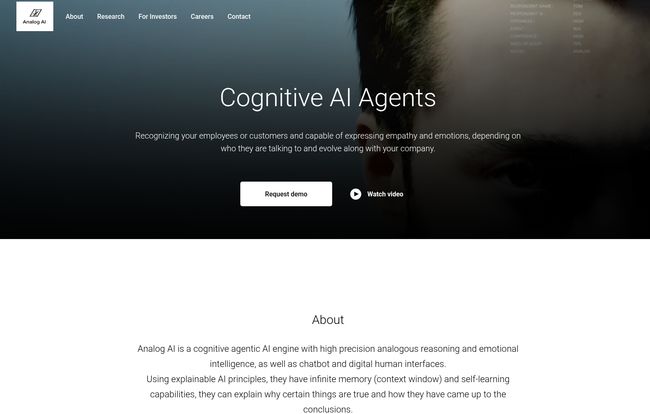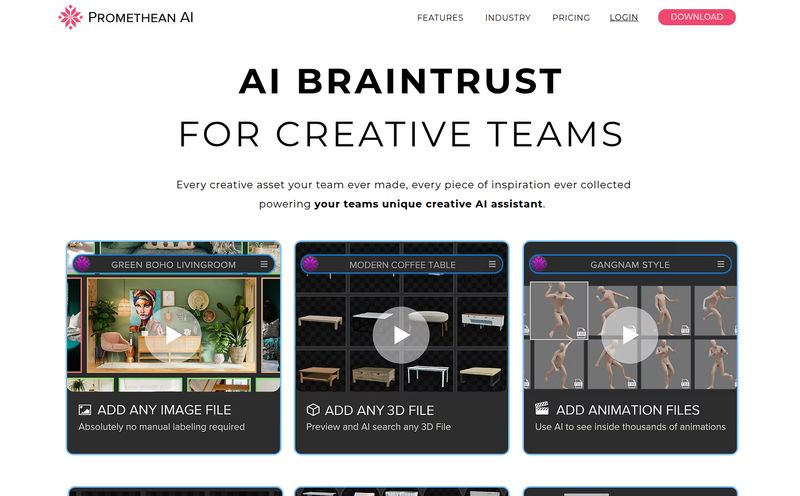I swear, if I have to type “speak to a representative” one more time into a chatbot that clearly doesn’t understand me, I might just throw my laptop out the window. We’ve all been there, right? Stuck in a digital loop with an AI that’s about as smart as a brick and as empathetic as a rock. For years, we've been promised intelligent assistants, but what we've mostly gotten are glorified parrots, good at repeating from a script but terrible at, you know, understanding.
But the ground is shifting. The conversation in the AI world is moving beyond just raw processing power and bigger data sets. The new frontier, the thing that could actually change the game, is emotional intelligence. And that’s where a company called Analog AI caught my eye. They’re not just building another chatbot; they’re building what they call “Cognitive AI Agents” – digital humans designed to have something akin to feelings.
Sounds like science fiction, doesn't it? Let’s take a look and see if it's the real deal or just more marketing fluff.
What Exactly is Analog AI?
First off, let's get one thing straight. This isn't just another wrapper on a large language model. Analog AI claims its engine combines a few different approaches, including neuro-symbolic AI and commonsense reasoning. In plain English? They’re trying to build an AI that doesn’t just predict the next word in a sentence but actually reasons about the concepts behind the words. It's the difference between knowing the script to a play and actually understanding the character's motivation.

Visit Analog AI
Their goal is to create digital agents that can recognize who they're talking to and respond with genuine empathy and appropriate emotions. Think of it as giving the AI a digital emotional spine. They can be happy, sad, curious, or even disappointed. This is a massive departure from the perpetually chipper, soullessly polite bots we’re used to.
The Heart of the Machine: Emotional Intelligence in Action
Analog AI's agents can apparently express 15 different emotions. Fifteen! That includes the basics like happiness and sadness, but also more complex ones like gratitude, boredom, and empathy. The real test, of course, is how this plays out in a real conversation.
Their own website gives a pretty fascinating example:
User: You are a movie director.
Analog AI: I am a movie director.
User: But I just said movie directors work hard.
Analog AI: I see, so I am working hard. (reasoning)
User: But I said YOU work hard.
Analog AI: Hmm, you just said movie directors work hard, but now you say I'm not? That's confusing! I think I'm still working hard, unless you've got a new perspective to share. (surprise emotion)
Okay, that’s pretty cool. The AI doesn’t just follow commands; it processes a contradiction, shows its reasoning, and then expresses a very human-like emotion: confusion mixed with surprise. It's a small thing, but it’s a world away from the “I’m sorry, I don’t understand” dead-end we get so often. This kind of interaction could completely change the feel of customer support, making it less of a chore and more of a conversation.
Beyond Chat: Where Can You Use These Digital Humans?
This is where my imagination starts to run wild. Analog AI isn't just pitching better customer service bots. They're talking about a whole suite of applications for their digital humans:
- Digital Clones: This one is wild. Imagine a digital version of yourself that can attend video conference calls for you. It's a bit Black Mirror, I wont lie, but the productivity implications are huge. This feature is noted as 'upcoming', so we're not quite there yet, but wow.
- Specialized Agents: They specifically mention their tech is well-suited for legal and medical professionals, where nuanced understanding is critical.
- Gaming NPCs: Imagine non-player characters in a video game that actually react to you with believable emotion instead of cycling through three pre-recorded lines of dialogue.
- Desktop Assistants and Digital Signage: More mundane, maybe, but having an assistant that understands context and tone could be a huge improvement.
The digital clone idea is the one that sticks with me. Part of me is thrilled at the idea of skipping a boring meeting, while another part is slightly terrified. It raises all sorts of interesting questions about identity and presence. But I guess that’s what happens when technology takes a real leap forward.
The Brains Behind the Feelings: How Analog AI Learns
Here’s another big differentiator: self-learning. Unlike many AI models that are trained and then remain static until the next major update, Analog AI agents are designed to learn continuously from their interactions. They have what the company calls “infinite memory.”
They even have a smart way to handle one of the most common AI fails: mishearing names. Their example shows the AI mishearing “Christopher Nolan” as “Kristen Noland.” The user can simply type the correction in the chat, and the AI learns it for all future interactions. For anyone who’s had to spell their name out phonetically to a voice system five times, this is a godsend. It’s a practical, simple feature that shows they’re thinking about real-world frustrations, not just theoretical benchmarks.
Let's Talk Money: The Analog AI Pricing Model
So, what does a digital human with feelings cost? You won’t find a simple monthly subscription on their pricing page. It’s a more bespoke enterprise model, which makes sense given the customization involved.
Here’s the breakdown:
- Usage Cost: Billed based on hours per day.
- Upfront Cost: A one-time fee for initial training and testing, which varies by company size.
Their big claim is that a digital agent can be 3-5 times more affordable than hiring a human customer agent. That’s a bold statement, and while the upfront cost might be a hurdle for some, the potential long-term savings are obviously a huge selling point. They also offer a 2-week money-back guarantee, which shows a decent amount of confidence in their product. To get a real number, you’ll have to contact their sales team directly.
The Rough Edges: Potential Downsides
No technology is perfect, and it’s important to look at the limitations. To their credit, Analog AI is pretty upfront about some of them.
The AI “may sometimes seem confused.” As we saw in the example, this can actually make it feel more human, but in a critical business interaction, confusion could be a bug, not a feature. It also “requires user interaction to improve,” which is a double-edged sword. It’s great that it learns, but it means there’s an initial period where you’re actively teaching it. Finally, they note that “occasional delays may occur” in responses, likely due to the complex processing happening in the background. It's a tradeoff for more intelligent, less-canned answers.
So, what’s my final take? I’m genuinely intrigued. Analog AI seems to be one of the few companies tackling the much harder problem of cognitive and emotional simulation, not just language pattern matching. It’s a step away from the cold, robotic interactions we’ve been forced to accept and a step toward something more natural, more intuitive, and frankly, more human.
It’s not perfect, and the 'digital clone' future is still a little ways off. But it represents a fascinating direction for AI. It’s a move from tools that simply execute commands to partners that can actually understand and collaborate. Are you ready to have a real conversation with an AI? Because it looks like that day is getting closer than we think.
Frequently Asked Questions about Analog AI
- What makes Analog AI different from ChatGPT?
- The primary difference is its focus on emotional intelligence and cognitive reasoning. While models like ChatGPT are masters of language, Analog AI is designed to understand context, express a range of 15 emotions, and learn continuously from direct user corrections in a way that feels more like true understanding.
- How does Analog AI pricing work?
- It's a custom pricing model. There is an upfront cost for initial training and setup, which varies, followed by a daily cost based on the number of hours the digital agent is active. They claim this can be 3-5 times cheaper than a human employee.
- Can Analog AI really feel emotions?
- This is a philosophical question! Technically, it doesn't 'feel' emotions like a human. It uses its advanced reasoning engine to determine the appropriate emotional response to a situation and then expresses it through facial animations and tone. For the end-user, the effect is a semblance of genuine feeling and empathy.
- What are the main applications for Analog AI?
- The applications are broad, including emotionally intelligent customer support bots, realistic video game characters, digital signage, desktop assistants, and even future 'digital clones' that can stand in for you in meetings.
- Is there a free trial for Analog AI?
- They don't offer a traditional free trial. However, they do provide a 2-week money-back guarantee on their service, allowing businesses to test it with a safety net.
- How does it handle mistakes in speech recognition?
- It has a self-learning feature where a user can correct a misinterpretation (like a name) by simply typing the correct version in the chat. The AI then remembers this correction for all future conversations.
Reference and Sources
- Analog AI Official Website
- Analog AI Pricing Information
- An Overview of Neuro-Symbolic AI from IBM Research



